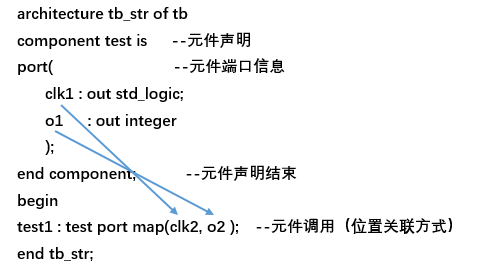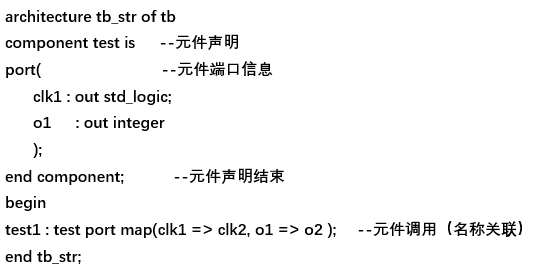**记录学习,记录成长
1.VHDL中元件的例化可分为两部分
第一部分:元件声明,声明要例化的元件。
第二部分:元件例化,声明结束之后就可以对元件进行例化或者说是调用了。
其中声明部分在结构体的说明语句部分(即architecture和begin之间)。而调用部分同一个结构体的电路描述部分(即begin之后)。
2.元件声明格式:
Component 元件名称 is
Port(元件端口信息);
End component;
提示:元件声明和实体声明一致,元件就是一个实体。
3.元件例化语句
例化名 :元件名称 port map 元件端口列表;
提示:port map为端口映射的意思。相互连接的两个端口,状态和数据类型必须一致。
端口连接方式有两种:一种是位置关联方式。一种是端口信号名称关联方式。
3.1 位置关联方式
位置关联方式下,端口的连接与端口列表中的顺序是一一对应的。

3.2 端口信号名称关联方式
端口信号名称关联方式比较直观,一般推荐使用此种关联方式。

此外,通过查找发现还有事先不进行声明也可进行例化的方式:
例化格式:
例化名 : entity work . 元件名(端口列表)
(https://blog.csdn.net/wyf100/article/details/8616491)
test1 :entity work.test port map(clk2, o2 );
#学习代码1
library ieee;
use ieee.std_logic_1164.all;
use ieee.std_logic_arith.all;
use ieee.std_logic_unsigned.all;
entity test is
port(
clk1 : out std_logic := '0';
o1 : out integer := 2
);
end test;
architecture teststr of test is
begin
process
begin
wait for 10 ns;
clk1 <= '1';
wait for 10 ns;
clk1 <= '0';
end process;
end teststr;
#学习代码2
library ieee;
use ieee.std_logic_1164.all;
use ieee.std_logic_arith.all;
use ieee.std_logic_unsigned.all;
entity tb is
port(
clk2 : out std_logic;
o2 : out integer
);
end tb;
architecture tb_str of tb is
component test is
port(
clk1 : out std_logic;
o1 : out integer
);
end component;
begin
test1 : test port map(clk2, o2 );
end tb_str;
#学习代码3
library ieee;
use ieee.std_logic_1164.all;
use ieee.std_logic_arith.all;
use ieee.std_logic_unsigned.all;
entity tb is
port(
clk2 : out std_logic;
o2 : out integer
);
end tb;
architecture tb_str of tb is
begin
test1 :entity work.test port map(clk2, o2 );
end tb_str;
最后
以上就是斯文大地最近收集整理的关于VHDL中元件(模块)的例化的全部内容,更多相关VHDL中元件(模块)内容请搜索靠谱客的其他文章。
本图文内容来源于网友提供,作为学习参考使用,或来自网络收集整理,版权属于原作者所有。








发表评论 取消回复